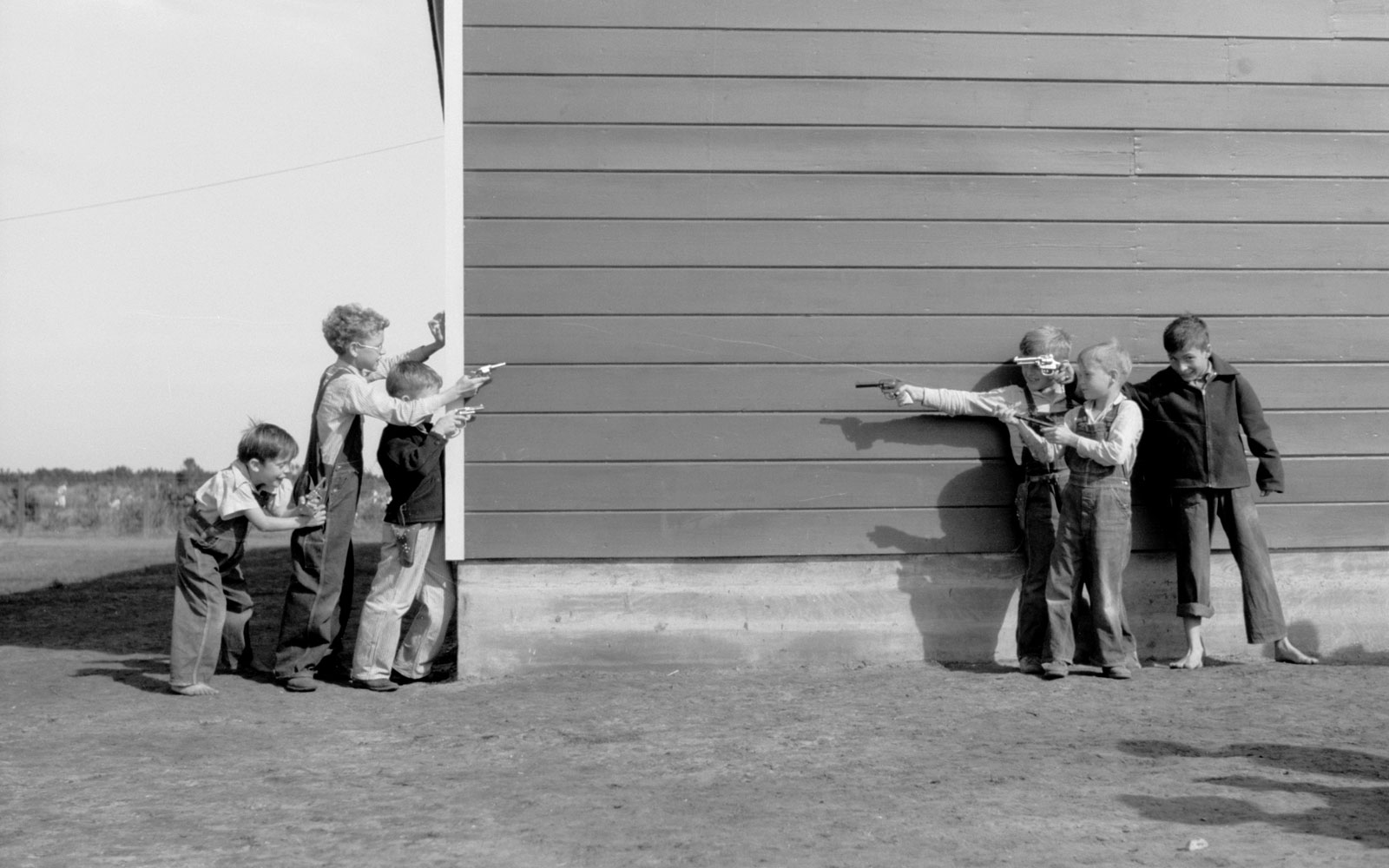
Kids playing Cowboys and Indians in Weslaco, Texas, 1942. Arthur Rothstein / Library of Congress, Prints & Photographs Division, FSA/OWI Collection, [LC-USF33- 003619-M3].
In less than two decades, new technologies and the internet have revolutionised the habits and customs of our society and brought about changes in many fields, including the video game industry. Today’s consoles boost the quality and the entertainment value of games, making them more appealing. Against this background, the popularity of games based on war and violence is still on the rise. Does demand create supply, or vice versa? Education for peace explores this issue and provides some answers. Thanks to Icaria Editorial, we offer an exclusive preview of the chapter “Neuroeducación y videojuegos bélicos” by Eduardo Salvador Acevedo from the book Mentes militarizadas. Cómo nos educan para asumir la guerra y la violencia coordinated by the Centre Delàs d’Estudis per la Pau and the campaign Desmilitaritzem l’educació.
The amount of virtual violence makes it seem as if Darwin’s metaphor of the struggle for survival – all against all – were coming true, as if new technologies were at the service of patriarchal power (Naranjo, 2014: 251), more interested in fragmenting society than uniting it. The game industry seems to be promoting a regression of human values and using increasingly extreme violence to attract audiences who swing between nihilism and the attempt to respond to the endless stimuli vying for attention.
It seems paradoxical that a culture of games based on war, fighting, death, and the banalisation of pain should thrive in today’s pleasure-seeking society, which describes itself as hedonist.
The leisure and pleasure industry has real geo-strategic political influence on the tastes and pastimes of citizens. Free time can potentially be spent on politics, reflection, and independent thought, but it can also be used in ways that boost patriarchal and consumer values. The multinational corporations that produce video games are not value-neutral. The culture of violence is no accident, and the demand for violence in games and attitudes does not spontaneously spring from the market. Countless media products promote a violent screen culture in films, on television, and in video games, but video games are different insofar as users actively participate as protagonists of the violence, rather than remaining mere spectators.
Societies controlled by violent impulses are more susceptible to emotional manipulation. It suits those in power to have a society accustomed to aggressive, uncontrolled emotions, because when these emotions are channelled by media corporations, consumers end up defending values that benefit them.
There is only one way to stem the wave of violence: to recover our sensibility for everything that is alive.Erich Fromm
The video game industry and playing with emotions
Video game sales did not suffer a downturn in the 2007 economic crisis. In 2013, sales increased 22% in the US, reaching a turnover of 16.9 billion dollars, of which 31.9% (5.4 billion dollars) can be attributed to war games
The quality and content of video games has evolved through several stages since the industry began a few decades ago, with images and realism improving at each stage. The Atari age in the eighties was followed by the Nintendo age in the nineties, and the Sony age from 2000 onwards (Kirsh, 2011): 137). In the Sony age, fiction has almost surpassed reality, and the category of action or war video games has become clearer. Games such as Call of Duty and Medal of Honour use the aesthetic strategy of blood spurting from the bodies of rebels, sometimes dressed in Arab attire, when the player kills them. These are games that recreate the constant stress of gunfire, bombs, and projectiles, with a soundtrack and realistic settings based on places such as Afghanistan. They include videos of officers talking to the troops about the importance of defending democracy and freedom of expression, addressing players as heroes defending the developed world against chaos. As for extreme virtual violence in action video games, the standard bearer is Grand Theft Auto or GTA.
Gratuitous violence and everyday life: GTA
GTA 5, which was banned in Australia (BBC, 2014), was ranked as the fourth best-selling game in the United States, generating annual revenue of more than a billion dollars. There are funny/brutal kill compilations based on GTA openly available on the internet, which show scenes such as a player driving a car and heading out to pick up girls on the streets, for example, and running them over or shooting them after having sex with them. In another compilation, the player is walking along, sees a woman, starts chasing her, and then beats her until she falls to the ground. The video includes images of the woman screaming or calling for help. This is a clear example of a game that specifically recreates violent sexist values. In another type of GTA kill, the character goes out on the streets and starts killing anybody who crosses his path, using a choice of different calibre weapons, machine guns, artillery, or, for a more intimate experience, knives. Once again, we see the phenomenon of the street and the phenomenon of the sense of power, which come up repeatedly at the intersection between war and the internet.

An image from GTA V used to highlight the game’s sexual violence in a Change.org petition.
GTA combines real, everyday situations on one hand, with new, violent elements that are introduced into this apparent normality. The entertainment value springs from the clash between two worlds and from breaking the code of conduct in a boring street where nothing exciting happens. There are examples of games that go further still: simulating a situation in which somebody breaks into homes while families are sleeping or watching television, setting off alarms. The player can choose a machine gun and wonder through the house taking a soldier’s pose, deciding who to kill: the young girl in her bedroom, her parents… These video games are said to increase the attention span of players, but perhaps they do so at the expense of making them more aggressive (Salvador, 2015: 1).
Tension or emotion?
The emotions that these games trigger are linked to a basic survival instinct:: emotions such as rage and fear, regulated by the amygdala (Redolar; 2014:662), the part of the brain that is less evolved and less rational, also in terms of feelings. The amygdala is part of the limbic system and it is the oldest part of the brain in phylogenetic terms – what is known as the “reptilian” brain, with basic emotional impulses. Mammals, of course, subsequently generated new areas of the brain, such as the cerebral cortex, which is linked to the capacity to feel emotions, form relationships, and resolve conflicts.
Sensory realism
Game design is becoming increasingly realistic, to the point where the characters appear to have human personalities, and the sounds and voices that they make are taken from real situations. The settings are also more realistic, with streets that look familiar, and passers-by who also look quite real. The same applies to the settings of war games, which appear to be copied from real life. So the player experiences being a soldier, and inadvertently absorbs military and war values.
Mental Split?
Given that we rarely encounter death in everyday life, extreme virtual violence means that
we have to separate the real and virtual worlds in our memories and consciousness. The majority of video game players behave normally in their everyday lives. But in gaming rooms, or alone in their bedrooms, these players give free rein to a new virtual personality and to destructive instincts, as if they had been there all along, suppressed, frustrated, or hidden.
Intensity and desensitisation
The emotional impact of a game like GTA is greater than other kinds of games because of the familiar settings. Even so, GTA is full of variations and new situations introduced by game designers to counteract the desensitisation (Anderson et al., 2010) that comes from seeing the same thing over and over again. There has to be an element of crescendo to ensure that the emotional tension (and interest) does not disappear from the game.
Academic studies are increasingly finding patterns reminiscent of drug addiction in internet users and video game players, and some experts have found correlations between the use of violent video games and behavioural changes, depending on the predisposition of individuals.
Users who play video games for more than four hours per day are found to become irritable when their playing time is restricted. And users who ignore friends, family, and responsibilities, neglect personal hygiene, or sleep badly due to excessive use are more likely to become addicted to pathological gaming. According to clinical experts (Miller, 2013), if these risk factors continue for three to six months, some of the symptoms of addiction will require professional or psychological treatment.
Violent video games have a greater impact than violent TV series because they require greater learning and interaction. The elements that make war video games different to TV series are precisely those that increase their impact (Kirsh, 2011:135), and also affect emotional memory and learning. The most obvious difference between watching a film on television and playing a video game lies in the fact that a film follows a pre-established script, while a video game puts the player in the role of the protagonist and, to some extent, the director, giving him a say in the scenes that play out. This means that the player steps into the attacker’s shoes and identifies with him, opening up the possibility of imitating his behaviour.
In addition, the enthusiastic, sometimes obsessive, or even addictive participation involves activity, repetition, and rewards, which are the foundations of learning.
Lastly, video games tend to cover entire sequences, so that the tension becomes more effective and the violence never stops. In other words, the intensity does not slacken in any scene, it remains constant.
Is there a correlation between video games and violence?
Studies in the field of the psychology of violence use quantitative paradigms that help us to understand what happens when we play violent video games. There are in fact many variations in the quality, type, and degree of violence (which can be more subtle or symbolic), which may be why researchers such as Ferguson and Anderson come up with conflicting results.
Although one study by Ferguson did not confirm the causal relationship between the use of violent video games and aggressive behaviour suggested by some previous studies, the author acknowledged that his study cannot be generalised to all population types, and that family, personality, or friendship differences may come into play (Ferguson, 2007) and (Ferguson et al., 2011). Certain personality types are particularly prone to becoming aggressive as a result of the ongoing use of these types of video games, for example.
Ferguson also studied the possible positive effects of video games based on a cathartic hypothesis (Sherry et al., 2007 in Ferguson, 2007), according to which violent video games may in fact reduce violent tendencies because they allow release and liberation. In response, Anderson et. al. (2011) carried out a new study based on a sample of subjects from Japan and Western countries, which contradicted the main conclusions found by Ferguson (the catharsis hypothesis and the lack of a correlation between aggression and violence). Later longitudinal studies have confirmed the possibility of a causal relationship between the use of action video games and aggressive behaviour, lack of empathy, and desensitisation (Gentile et. al., 2014).
At the same time, magnetic resonance studies seem to confirm the idea that exposure to action video games by expert players suppresses affective areas of the rostral anterior cingulate cortex and of the amygdala (Mathiak and Weber, 2006). The results of a parallel experiments on new players show precisely the opposite effect, with the stimulation of these areas of the brain (Gentile et al., 2014). This suggests that ongoing use of these violent video games generates a pattern of desensitisation in line with the intensity of violent emotional response, and decreases player empathy, in accordance with the findings of Anderson et al. (2010). Further studies suggest a correlation between the use of violent video games and the frequency of violent thoughts (Arriaga et al., 2011).
The age factor
Players aged between four and eleven are most vulnerable to exposure to violent material, due to greater brain plasticity and the possibility that dysfunctional models and patterns may be fixed. New “neuron highways” could strengthen quicker, automatic brain pathways (Redolar, 2014: 645) and bypass the slower pathways that move through the cortex (cortical evaluation), leading to greater impulsiveness and less capacity to resolve conflicts.
It should also be noted that other studies confirm that the effects are stronger on new players than on regular players of action video games. Less expert players suffer a greater desensitisation when they start playing, while frequent users are already desentisised, and this allows them to play more effectively.
Alternatives to violent video games
Nothing suggests an imminent decrease in the use of violent video games. Virtual violence is on the rise, and it is even becoming normalised in other sectors beyond games: seeing the blood spurt out when somebody is shot is now considered funny rather than abnormal, not only in films but also in entertainment programmes.
The critical use of video games
In the education sector, we need to more actively draw attention to the disproportionately small amount of online and mass media information promoting critical consumption that promotes a culture of peace, based on human values and non-violence. Pleasure (and entertainment) is political, so we need to be critical and aware of the values that are imposed along with mass culture and entertainment. The values of the pacifist ideal are embodied by games in which emotions operate in a pure state: face-to-face games that are played cooperatively in groups, that are non-competitive and not based on consumption. These games should incorporate an interpersonal, socio-affective component and they should be based on an understanding of society and its real and desirable functioning.
To offset the possible effects of violent video games, there should be age limits and parental control of the use of games that include extreme violence (Arriaga et al., 2011), but these strategies should go hand in hand with the promotion of alternative games with a similar or greater component of play, digital or otherwise. The new paradigm of pleasure or fun must be linked to awareness and a critical spirit, to individual and social consciousness. And in any case, it should include the least possible cultural violence (Galtung, 1989: 7).
Games: an opportunity to learn about values
For young children, games are an educational opportunity to learn, which means that play has great potential as a tool for memorising formulas and learning complex concepts. The educational potential of games also applies to adults, but in reality we find that conditioning factor of learning gradually fades as we get older, and we tend to fall into consuming games in an essentially non-critical way. This increases our exposure to the values of the primary stages of the development of consciousness (Kohlberg, 1981). These types of games would fall under a naive hedonism, in which players follow a set of rules in order to attain generally egoistical goals and intense emotions such as fear and rage.
As an alternative, we can begin to talk about console or computer games that reduce the amount of violence and raise the level of moral consciousness. A first step in this transition could be to shift from violent games based on pre-conventional morals to competitive games based on more conventional values. Sports or competitive games set rules that curb selfishness while maintaining the tension. Their philosophy is not specifically oriented towards destruction, but towards improving performance, seeing the other as an opponent or obstacle to achieving your desire. Competitive games remove direct virtual violence, but keep symbolic virtual violence.
What’s missing, according to the philosophy of education for peace, is the aspect of solidarity, the idea of unity in which the other is seen as part of oneself, not as an enemy. With this solidarity, horizontality and equality, violence is eliminated (Galtung, 1989:12) at all levels: play, work, and coexistence.
Games that increase ethical action and awareness are based on post-conventional morals, which are grounded in a deep grasp of human rights philosophy and practice that allows them to go beyond conventional norms, which may be arbitrary and not valid in all situations. A moral philosophy based on a higher order of universal ethical principles entails seeing the world as a universal whole, in which individuals and cultures work towards unity. A philosophy that openly questions the patriarchy and the alienating values of consumption and individualism. It seems paradoxical, but in our connected society we are increasingly disconnected from ourselves and from each other.
Paco Cascón argues for the importance of face-to-face, social and emotional games that are fully in line with philosophy for peace, and generate a social consciousness along with personal growth and self-knowledge (see the education-for-peace games in the links below).
In addition, new forms of self-knowledge and emotional learning increasingly emphasise music, the body, art, and movement, while remaining self-aware, looking inwards and outwards at the same time. The response to this collective consciousness appears to require a calm self-knowledge, which implies social consciousness but also a well-nourished individual consciousness (including bodily consciousness) that is in harmony with nature. In this sense, meditation and other means of attaining inner peace are increasingly becoming a prerequisite to continue working for peace.
Examples of consciousness games
Two methodologies based on face-to-face games, combining in-depth group dynamics and pacifist values have been developed as an alternative to violent games that promote the culture of war. One is called “Reflectacción”, and the other is Theatre of the Oppressed, or social theatre.
Reflectacción uses a methodology based on play and social awareness, in the form of games and dynamics that generally extend over two or more days. Players usually book accommodation so that they can sleep and eat in the same place. This means interaction can continue beyond the game and the activities, so that players can get to know each other and themselves.
Meanwhile, social theatre or Theatre of the Oppressed is a method that links creative play with the cultivation of social awareness as a group or a culture. In this version of social theatre, participants work with a three-scene story based on a case of social or personal oppression, which can express or show particular situations or realities, and encourage both participants and audiences to reflect on them. This method also promotes connections and emotional intelligence (Salvador, 2011:1), which is absolutely essential for self-knowledge and conflict resolution.
Conclusions
As we have seen, the culture of violence is not a matter of chance. War video games are based on a whole patriarchal aesthetic and a specific kind of social engineering that favours the banalisation of extreme violence and indoctrinates military values, idolising destruction and war technology as beautiful and powerful.
To counteract this, we have to build up a culture of peace from the ground up, and avoid falling into the temptation of non-critical consumption. This means we have to be selective in the use of video games for conscious learning and education, given that games can be highly beneficial in areas like maths, history, and learning about other languages or cultures.
Video games are a way of making education more appealing. Even if the causal link between violent games and violent behaviour is small, there is a big danger of these video games falling into the hands of people with a predisposition to violence. So those of us who work towards a culture of peace argue against video games with violent or patriarchal undertones, in favour of cooperative games that are primarily played face-to-face, with a secondary virtual component.
There are increasingly video games that aim to promote the values of peace and solidarity, sometimes produced by the same brands that market war games, such as X-Box. As such, it is important for educators to test the games in advance, in order to ensure that video games that describe themselves as “pacifist” do in fact promote anti-militarism, peace, and solidarity.
More importantly, video games should not be the only form of entertainment, even if the mass media push this idea. Video games for peace or games based on online interaction among young people in different countries can be useful tools, but we should not forget that games based on socio-affective play and interactions are the ones that best promote pacifist values.
More information
- Educational materials. Centre Delàs d’estudis per la pau.
- Edupaz. Ediciones la Catarata.
- Education for peace games and dynamics. Escola de Pau. Universitat Autònoma de Barcelona (UAB).
- Research for Peace resource centre. Grupo de Acción Comunitaria.






Martin | 04 August 2016
Buen artículo, gracias !
Temiko | 25 August 2016
Amazing article, referencing valuable further reading. This ought to be published to the mainstream media.
Pau | 26 July 2016
Hi ha massa desinformació.
Leave a comment